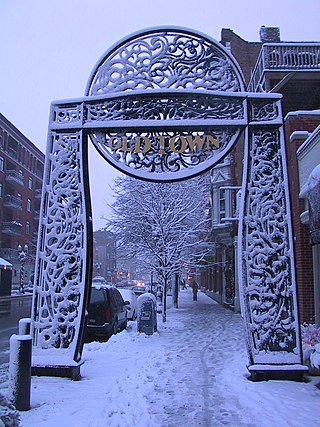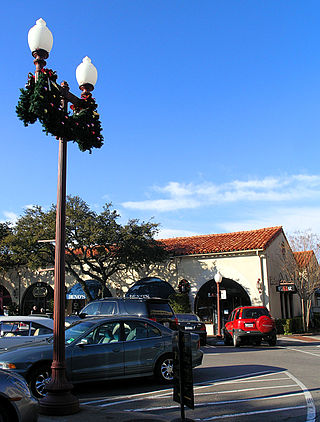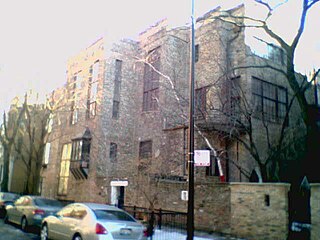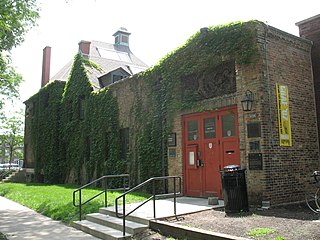
Old Town is a neighborhood and historic district in Near North Side and Lincoln Park, Chicago, Illinois, home to many of Chicago's older, Victorian-era buildings, including St. Michael's Church, one of seven buildings to survive the Great Chicago Fire.

Highland Park Village is an upscale shopping plaza located at the southwest corner of Mockingbird Lane and Preston Road in Highland Park, Texas and was the first self-contained shopping center in America. The Highland Park Village was declared a National Historic Landmark in 2000.

The Maitland Art Center is a historic site in Maitland, Florida. It was founded and designed by architect and artist J. Andre Smith (1880–1959) in 1937 as an artist colony, dedicated to experimental art. Funded by philanthropist Mary Curtis Bok, the colony hosted artists such as Ralston Crawford, Milton Avery, and Consuelo Kanaga. It is located at 231 West Packwood Avenue. On November 17, 1982, it was added to the U.S. National Register of Historic Places.

Washington Square, also known as Washington Square Park, is a park in Chicago, Illinois. A registered historic landmark that is better known by its nickname Bughouse Square, it was the most celebrated open air free-speech center in the country as well as a popular Chicago tourist attraction. It is located across Walton Street from Newberry Library at 901 N. Clark Street in the Near North Side community area of Chicago, Illinois, United States. It is Chicago's oldest existing small park. It is one of four Chicago Park District parks named after persons surnamed Washington. It was added to the National Register of Historic Places on May 20, 1991.

The Carl Street Studios is an enclave in Chicago's Old Town neighborhood.

The Central Park West Historic District is located along Central Park West, between 61st and 97th Streets, on the Upper West Side of Manhattan in New York City, United States. The district was added to the National Register of Historic Places on November 9, 1982. The district encompasses a portion of the Upper West Side-Central Park West Historic District as designated by the New York City Landmarks Preservation Commission, and contains a number of prominent New York City designated landmarks, including the Dakota, a National Historic Landmark. The buildings date from the late 19th century to the early 1940s and exhibit a variety of architectural styles. The majority of the district's buildings are of neo-Italian Renaissance style, but Art Deco is a popular theme as well.

The Union Station, at 801 South 10th Street in Omaha, Nebraska, known also as Union Passenger Terminal, is "one of the finest examples of Art Deco architecture in the Midwest". Designated an Omaha Landmark in 1978, it was listed as "Union Passenger Terminal" on the National Register of Historic Places in 1971, and was designated a National Historic Landmark in 2016. The Union Station is also a contributing property to the Omaha Rail and Commerce Historic District. It was the Union Pacific's first Art Deco railroad station, and the completion of the terminal "firmly established Omaha as an important railroad terminus in the Midwest".

The Black Metropolis–Bronzeville District is a historic African American district in the Bronzeville neighborhood of the Douglas community area on the South Side of Chicago, Illinois.

The Lorado Taft Midway Studios are a historic artist studio complex at South Ingleside Avenue and East 60th Street, on the campus of the University of Chicago on the South Side of Chicago. The architecturally haphazard structure, originating as two converted barns and a Victorian house, was used from 1906 to 1929 as the studio of Lorado Taft (1860-1936), one of the most influential sculptors of the period. A National Historic Landmark, it now houses the university's visual arts department.

The Villa District, also known as Villa Historic District, is a historic district in Chicago, Illinois, United States. It is located on Chicago's Northwest Side within the community area of Irving Park. Its borders are along Pulaski Road to the west, the Union Pacific/Northwest rail line to the north, Hamlin Avenue to the east, and Addison Street to the south. Located directly north of the Wacławowo area of Avondale, the Villa District is serviced by the Blue Line's Addison street station.

The Whitney Museum of American Art's original building is a collection of three 1838 rowhouses at 8–12 West 8th Street, between Fifth Avenue and MacDougal Street, in the Greenwich Village neighborhood of Manhattan in New York City. In 1907, Gertrude Vanderbilt Whitney established the Whitney Studio Gallery at 8 West 8th Street adjacent to her own MacDougal Alley studio. This, and the later Whitney Studio Club at 147 West 4th Street, were intended to provide young artists with places to meet and exhibit their works.

Downtown Santa Ana (DTSA), also called Downtown Orange County, is the city center of Santa Ana, the county seat of Orange County, California. It is the institutional center for the city of Santa Ana as well as Orange County, a retail and business hub.

The Alexandria Historic District is a National Historic Landmark District in Alexandria, Virginia. Encompassing all of the city's Old Town and some adjacent areas, this area contains one of the nation's best-preserved assemblages of the late-18th and early-19th century urban architecture. The district was declared a National Historic Landmark in 1966.

The Michigan–Wacker Historic District is a National Register of Historic Places District that includes parts of the Chicago Loop and Near North Side community areas in Chicago, Illinois, United States. The district is known for the Chicago River, two bridges that cross it, and eleven high rise and skyscraper buildings erected in the 1920s. Among the contributing properties are the following Chicago Landmark structures:

Rossleigh Court, constructed between 1906 and 1907, currently is a rental apartment building located on the northwest corner of 85th Street and Central Park West in the Upper West Side of Manhattan in New York City.

The Church Hill North Historic District is a historic district in Richmond, Virginia, that was listed on the National Register of Historic Places in 1997. An expansion of the district was listed in 2000. This added 37 acres (15 ha) to the original 70 acres (28 ha)

The Dr. Philip Weintraub House is an early modern single-family house in the Hollywood Park neighborhood of Chicago, Illinois. Located at 3252 W. Victoria Street, the home was built in 1940 by architect Andrew Nicholas Rebori (1886-1966) and artist Edgar Miller (1899-1993) for Philip Weintraub.
James Edgar Miller (1899–1993) was an American designer, painter, craftsman, master woodcarver and one of the nation's foremost stained-glass designers. He could sculpt and draw, and he was considered a pioneer in the use of graphic art in advertising. In the 1920s, he was called "the blond boy Michelangelo"; in the 1930s, "a new luminary" by Architecture Magazine; in the 1940s, "one of the most versatile artists in America." By the 1950s, he was the go-to guy for some of the nation's most successful industrial designers.

Jesús Torres was a Mexican-American artist, sculptor, and designer. His facility with multiple artistic media, including clay, tile, wood, metal, and leather, made him a frequently-commissioned craftsperson in Chicago's during the 1930s and 1940s. He was one of several immigrant artists who began their practice at Jane Addams' Hull-House in the 1920s. Notable solo works include his final commission, where he was hired by the Pullman Company to design the interiors of five cars for the Golden State Limited, which traveled throughout the American Southwest.




















